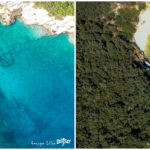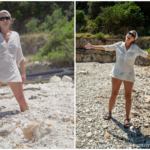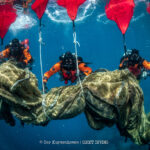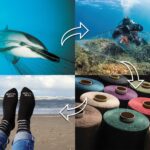
(text starting at interview, not introduction)
Crystal: Hi, Jenny. Thank you so much for joining me on forces for nature. It’s so great to have you.
Jenny: Hello, crystal. Thank you for having me. It’s very nice to be here.
Crystal: So let’s dive right in. What are ghosts now?
Jenny: Ghost nets are nets that are left or abandoned in the seas and ocean and continue to catch fish without human involvement.
They appear almost invisible underwater, especially the very thin gillnets. So that’s why we called them ghost nets. That’s why they take this name.
Crystal: Is this really that big of a problem? How pervasive is it?
Jenny: Actually it is. So it’s estimated that 640,000 tons of fishing gear are lost or abandoned in the seas and ocean each year.
So it’s a huge environmental problem that many people don’t know about because it is unseen. It happens below water.
Crystal: Why is it an environmental problem? What do they do? Well,
Jenny: two reasons. One is because, like I said before, they catch Marine life that suffers that eventually dies in these nets. And the second reason is because fishing nets are mostly made of plastic.
So like any other type of plastic waste, they don’t decompose. They just keep losing microplastics. As time goes on, you know, they don’t dissolve. And these eventually end up in the stomachs of fish and eventually our own plates. Also what we call a cycle of death, going back to marine animals. So a small Marine animal might get trapped in a fishing net and then it attracts a larger predator that tries to feed on it and it gets stuck in the fishing nets and it keeps going on and on how do these nets
Crystal: even end up there?
Like, how are they lost or abandoned?.
Jenny: Weather conditions is definitely a one reason. So if a Fisher he sheet is trying to fish and the weather gets bad, they can lose their nets. For example, or even like a fish farm can lose its nets because of a storm or something like this.. Fishing nets can get snagged on rocks or reefs, and the Fisher cannot pull it out.
They need to cut them. We should say that fishers do not deliberately lose their, their gear in the sea. This costs money for them. It’s a financial loss. So it’s usually because of these two reasons that nets get left behind. What happens is very often we find these nets on reefs or on shipwrecks because these objects are good feeding grounds for fish and fishers know that fish finds shelter there and food.
So fishers know where to go to get their fish. And that’s where the nets get snagged..
Crystal: Of course, that makes a lot of sense. Now you work for an organization called Healthy Seas that is doing something great about this problem. Can you tell me a little bit about Healthy Seas?
Jenny: Sure. Yeah. Healthy Seas is a non-profit environmental organization.
We were founded in 2013 in the Netherlands and we have three pillars. The first one is cleaning up the seas around Europe and beyond from these ghost nets, we work with volunteer divers who are specially trained to dive at depths up to 60 meters and find these nets, cut these nets and remove them to clean the seas.
The second pillar is education. So we do a lot of school programs, again in many countries in Europe to teach school children and adults as well about this ghost fishing phenomenon. And the third pillar is the regeneration pillar. So we take the fishing nets and we facilitate that transport and all the logistics.
So they will become new products and the case of nylon nets, we work with a company called Aquafil, actually, they’re one of our founding partners. Uh, they have this technology to regenerate nylon into brand new yarn called Econyl. So they take the nylon nets, and other nylon waste pre and post consumer waste, and they produced a new yarn.
And also very importantly, we work with fishermen, fisher’s, to take their waste nets before they end up becoming ghost nets before they end up in a landfill or the natural environment. So we take their nets and we make sure they’re also recycled. That’s fantastic.
Crystal: I want to explore all of that more.
Let’s start with, how do you find the nuts in the first place? How do you know where they are?
Jenny: Okay. So in the sea, you mean? Yeah, well, unfortunately they’re everywhere.. As I mentioned previously, 640,000 tons a year is a lot. And so the divers, they do surveys or they get tips from fishers that I lost my nets there just regular recreational divers might give us a tip, but like for example, in the north sea, there are specific wrecks that the divers, the volunteers have been diving for many, many years and still there’s so much to do. So it’s not like they can clean it up on one cleanup dive. They keep going back and just continuously to clean the mess.
And there’s also platforms where people can report lost nets platforms online, uh, for example, and goes diving.org. Yes. They have a online form that, uh, anyone who discovers or wants to give us a tip can do that. Or the
Crystal: nets, are they small, medium or large? Like, are you able to determine by the size of the net problem is like from the industry or maybe small fishers?
Jenny: Oh yes. Well, there’s different types of nets. Okay. There’s trawler nets that are thicker and bigger and there’s Gill nets that are really, really fine. And those are the worst for Marine life. So for example, the public is used to measuring achievement or impact by a certain weight. You know? So for example, we have, since our founding, we have removed 773 tons of fishing nets, another Marine litter.
Okay. So that sounds like a lot, but for example, a gillnet, that is also called the curtain of death because it’s really just hanging there, you can’t see it weighs nothing, a trawler net might be less dangerous to the animals, but it’s really heavy, so big. Or, you know, if something is bigger, doesn’t mean it’s more dangerous to a specific animal cause gillnets are really fine, but they’re the worst.
Crystal: Well, I, I guess I meant just in terms of like you have. Big fishing industry boats versus smaller, small
Jenny: fishers. Yeah. So trawlers, the thicker nets that I was describing before, those are usually from bigger boats or fish farms. And, uh, right now we are running research like a scientific project in the Adriatic and north sea.
So we have scientists researching what we find on shipwrecks to determine the source. Of these fishing nets. And, you know, we hope that by determining the source, it will help us find a solution. So they’re looking at the different types of nets and where they’re coming from.
Crystal: Do you have any stories that you can share from any of the recovery dies?
Jenny: Yeah, sure. I mean, we have so many, I’m going to, I would love to talk about our, our last big event. This was in Greece. It was called journey to Ithaca. I don’t know if you’ve ever heard of Ithaca. It is the island of a Odyseus. It’s a small island in the Ionian sea. So we got a tip from a local. Actually this local did not only tip us.
He tipped the world. There was like a big environmental catastrophe going on because 10 years ago, a fish farm went bankrupt and abandoned. All its stuff like cages, like everything right there. All the rings. Uh, entire fish farm was just abandoned. So because of weather and just the years that were going by, it was getting destroyed.
Everything was collapsing and causing an environmental catastrophe, navigation, risks. I mean, people could not just take their boat and go into that area because their propeller might hit a fish farm ring. For example, there was a big hurricane in Greece last September. That just completely. Destroyed it. And we went there last summer with a 20 volunteer divers and another big team of surface volunteers.
We call them to clean this mess up at least the sea part, because there’s also a land part that has not been, it’s still there with hundreds of tons of waste on it. And we collected 76 tons of Marine litter. If you’ve seen the fish farm rings, they float because they’re filled with polyesteryn foam beads..
These had broken and there was a particular beach. The foam beads were up to the knee. And our volunteers clean this all up and even like fitted industrial vacuum cleaner, ended up vacuumed up every last bead from this beach. We have amazing before and after photos, but this all happened eight days. So 76 tons.
Of fishing equipment. And, uh, there was some tires and some other things as well that we removed last summer from Ithaca. So that’s a great story because somebody just left the nets there. And then an environmental group when, and cleaned it up. We had a lot of support from our partners and were able to do this thankfully, but yeah, things like this can happen.
It’s sort of like an environmental crime, I would say. For a business to just leave their stuff there.
Crystal: And are there any laws that somebody can go back and persecute this company?
Jenny: We’re not doing that ourselves, but it’s a very complicated situation. Let’s just say that it’s very complicated, but yes, there are environmental crimes happening all around us.
We were able to deal with this one. I mean, thankfully this local would he did, he couldn’t stand the sight cause, like, there was two bays and four beaches affected by this catastrophe. And he went there, he took pictures, underwater, aerial photos, surface photos, and posted them on Facebook. So then that attracted media attention, we found out about it and we were able to do something about it.
So it’s a really great story of what one person with the camera and the will to do it can achieve.
Crystal: Yes. Yes. Thank you for saying that because it really. We can be so powerful more than ever nowadays. So that’s wonderful. Congratulations.
Jenny: It’s amazing. And the locals call it 2021, the year of the cleanup.
I mean, they were dealing with this for 10 years. Oh. Of that
Crystal: abandoned farm.
Jenny: Like I think it was like 26 fish farm rings., 26. My goodness.
Crystal: Please do, and I’ll put them up in the, um, the show notes on the website. Amazing. And so another thing that you had mentioned that you guys do in addition to cleaning up these nets is the regeneration of them.
Please tell me a little bit more about that.
Jenny: Yeah. So our tagline is a journey from waste to wear. So you should look at Healthy Seas, like a platform, because, so our team is quite small. We’re six people, but we work with many volunteers, as I said before, the divers is so mostly from the ghost diving organization.
So that’s like from waste, that’s that part. To wear it means that we take the fishing nets and we make sure they are recycled. One stream is Aquafil. Like I described before they take the nylon nets and they regenerate them with other nylon waste, either a post-consumer like from carpet fluff. For example, or pre-consumer like industrial waste that’s nylon.
So they take all these sources of nylon and they regenerate them into a yarn called Econyl, which has exactly the same qualities as a nylon made from Virgin oil. For example, it has the same qualities and there’s a lot of brands that are turning now to Econyl their products. So for swim wear active wear accessories, I mean, you can even make sunglasses from Econyl.
And a lot of these brands are startups. They are founded by people who just really care about fashion and really care about the environment. So, and they support healthy seeds by becoming our partners and offering us 1%, at least 1% from their sales. But also they are our ambassadors and I think that’s also very important.
So that’s one stream, the nylon there’s other types of nets, plastic nets that are not nylon that we also find, find a way to recycle, for example, through a partner bracenet. That makes handmade accessories. Their flagship is the bracelet. So it’s a bracelet and they just clean them, wash them and upcycle them, fill them into very cute bracelets that, uh, are a great conversation piece.
You know, people love those. Other types of waste would collect, can give to artists many times artists or designers reach out to us because they want us to provide them with this material so they can make an art project or prototype for something. So that’s another way that we reuse what we collect.
Crystal: I actually read a stat that making nylon from Virgin oil takes up to five phases, but making the Econyl from the fishing nets only takes three phases.
And so the production process actually generates 55% less CO2 emissions than original nylon. So you even have that benefit.
Jenny: For sure. You probably read this in the Econyl website. I cannot verify. I don’t remember exactly, but I’ve been to the plant that they make Econyl in Slovenia. And I can test to the fact that they are very innovative and they’re constantly just investing in new innovations to become even more sustainable.
Crystal: And I do have to say that I’ve started seeing Econyl. More and more regularly, even in, in big name brands. For example, I have yoga pants and a bathing suit, both made from Econyl that, or are from a bigger name brands. So it’s starting to become more popular, which is wonderful because it gives people the choice to, to buy
Jenny: that.
And indeed, do we mention brands on this podcast? Because I can mention a few big brands like Prada. Oh, I don’t have those Bob Stella McCartney.
I don’t, I don’t either, but they’re using Econyl. Yeah. They’re using Econyl as well. And we are partner with some big brands as well. Although I do like to discuss the smallest brands because, like I said, really, there are people who just really care about the environment. And like I’ve heard from one designer, very young, I think 24, she is, or 25.
And I asked her, how did you come to make this brand? And she said, well, I loved fashion. I always wanted to do fashion, but I read that it’s like the second most polluting industry. So that stopped me. But then I discovered Econyl. So I did it, you know, cause I, I could help planet as well. Yeah.
Crystal: And you have brands and in a shop on your website, right?
Jenny: Yeah, for sure. We showcase all the, our partners and their products. For example, you mentioned that more and more brands are using Econyl in the last five years. Our partners increased by eight times. So there’s definitely more brands using Econyl.. Our shop, healthyseas.shop, or we just launched it two months ago.
And that offers products that are not from Econyl. Those are just products that are Healthy Seas products that our own team curated or designed in some cases. So like a t-shirt and a, it goes to the diver and some other items, but anyone who’s interested about the Econyl products can definitely go to our website and look at our partners products.
But they cannot buy directly from there. Got it.
Crystal: Now, do you personally have a moment when you said to yourself, this, this is why I do it.
Jenny: I, I did some years ago have this moment. I organized a fashion design competition among design students, and they used Econyl as their material with other recycled or eco-friendly materials.
And there were like 20 to 25 years old and yeah, they told me, opened our eyes to it. So definitely those moments are when we see the younger generation light up, discover something, um, make the connection and, um,
Crystal: It’s wonderful what you guys are doing, but the best thing would be to even prevent this from becoming a problem.
And you guys are even trying to do that. Tell me how I guess.
Jenny: So by working with fishers and Greece, Italy, Croatia, the Netherlands, we talked to them, raise awareness, explained to them, show them the, our flagship product, the socks, Healthy Seas socks. And they’re amazed that what they consider a very. Every day, low quality fishing net can get a new life and become something useful by seeing the actual products or they get convinced and we get them to give us their wastes nets before they end up in the landfill or worse.
That’s the most important part of the job. Probably the most difficult as well, because they’re quite a special group. Traditional. You know, set in their ways. I mean, it’s one of the oldest professions. So to infiltrate is a challenge, but it’s very rewarding for sure.
Crystal: This is a really great example of the circular economy, where you have a product that’s and of life is not going to be a landfill, but rather regenerate it into something that can be used again.
And you just have a closed loop system instead of. Like I said, ending up in landfill and I know that’s what a lot of organizations and people are talking about these days. So that’s a great example of, for, for anyone who’s heard it and didn’t quite understand the concept.
Jenny: A lot of these brands are trying to close the loop together with Econyl, because.
Okay, so, and you swimsuit is produced and what happens at the end of its life. It should be taken back and recycled again and Econyl is infinitely recyclable, but that means that from a design point of view, it shouldn’t be mixed up with other materials. So it’s nylon, it’s nylon. If you start mixing it up with other plastics and it’s very difficult to recycle again, or to go back and loop.
So everything is about the design circular economy needs to be. Considered at the very beginning when you’re designing a product, that’s really great to know, you know, if you’re mixing it nylon with cotton or nylon with whatever, then how you’re going to recycle it again.
Crystal: Good. For all those fashion designer, listeners out there to keep in mind, what else can our listeners do to help?
Jenny: For me, it all goes back to being a conscious consumer. Because over consumption or bad consumption or whatever is that’s what has gotten us here. The planet is suffering. And so are we, so I think it all comes back to being conscious consumers before we buy. We should think we should read about how the product was made, what sources and we shouldn’t just be clever about it.
Not just buy without any information. Yeah. I think that would really help.
Crystal: And we were mentioning earlier too. Um, for example, I’m a diver and I happened to live in Italy. Could I volunteer for you guys? Really?
Jenny: Yeah. Oh, okay. So, well, the divers that volunteer with us are specially trained. I’m not,
Crystal: but if somebody
Jenny: is, but you can, if you see something, you can tip us to it.
And you can definitely contribute in other ways as well. I mean, for example, in Italy, we have environmental education programs going on that we need volunteers for. We use a platform called timecounts.org, and that’s where whoever is interested, can sign up and, uh, send us their information and tell us what they’re interested in doing.
So for divers, you should get in touch with ghostdiving.org. Because that’s the group that we mainly work with as far as that part of the work, but there’s so many other ways one can help us
Crystal: and raising awareness, right. It just getting the word out there because I mean, this is an issue that very few people know about and it’s quite an issue.
Do you guys have an equivalent organization or a partner over like in the U S north, south America
Jenny: area? No, we’re not working with someone in the US but we are looking to expand into the US this year, actually west coast. We’re so excited.
Crystal: Well, this has been wonderful, Jenny, really happy to have learned more about this issue and to have heard your stories.
Thank you for all that you do. You’re making a difference.
Jenny: Well, thank you, crystal, for helping us raise awareness on this issue mean. In the past year is ghost nets. Ghost fishing is becoming more and more known. Thanks to people like you.
Have you seen the images of whales dragging buoys wrapped around their tails? Or turtles entangled in ropes? These are examples of what is called “ghost gear,” which are lost or abandoned fishing nets or gear that then aimlessly drift through the ocean, catching whatever comes into their path. Jenny Ioannou is with Healthy Seas, an organization dedicated to fixing this problem. Their work focuses on the retrieval of this pollution from the sea, prevention activities, and awareness building. And, once these materials are removed from the ocean, they work with partners to have them recycled and given a new life as a material called Econyl (used in a lot of today’s sustainable fashion).
Highlights
- What is ghost gear?
- What kind of impact does Healthy Seas have on marine ecosystems?
- How does Healthy Seas contribute to circular economies?
What YOU Can Do
- Volunteer with or donate to Healthy Seas.
- Report abandoned fishing gear to your local authorities or ask for help from organizations like Healthy Seas.
- Throw away your trash in the proper receptacles.
- Do not cut your fishing lines and let them go into the water.
- Look for products made from Econyl. You can find all sorts of products from their partners on the Healthy Seas website. (It’s important to mention that Econyl acts just like virgin nylon in that it also sheds plastic microfibers when washed. To keep those fibers from going into the water system, use a bag such as a Guppy Friend when washing them.)
Resources
If you enjoyed this episode, be sure to subscribe, rate and review it! This helps to boost its visibility.
Hit me up on Instagram and Facebook and let me know what actions you have been taking. Adopting just one habit can be a game-changer because imagine if a billion people also adopted that!
What difference for the world are you going to make today?
WANT TO ALSO BE A FORCE FOR NATURE?
Sign up below for a fantastic (and free!) guide to help you start taking practical actions today! Plus, you’ll be subscribed to receive the newsletter with podcast show notes and even more action tips.







Recent Comments